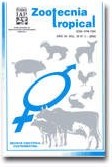
|
Zootecnia Tropical
Instituto Nacional de Investigaciones Agrícolas Venezuela
ISSN: 0798-7269
Vol. 29, No. 4, 2011, pp. 445-453
|
 Bioline Code: zt11039
Bioline Code: zt11039
Full paper language: English
Document type: Research Article
Document available free of charge
|
|
|
Zootecnia Tropical, Vol. 29, No. 4, 2011, pp. 445-453
| en |
Accumulated productivity at weaning in Large White, Lanandrace and Cross sows in a commercial herds
López, Nelson & Galíndez, Rafael
Abstract
With the aim to evaluate the lifetime productive of Large White, Landrace sows, and reciprocal cross, 2444
records of accumulated prolificacy (TAD) and litter weaning weight (PAD) were analyzed. Records of sows came
from a commercial herd of Yaracuy State. The data were adjusted by month, year and farrowing number. For
the final analysis were grouped the sows birth years in two periods: 1986−1998 and 1999-2005. We considered
the sows that had the opportunity to have at least three farrowing. Variance analyses were performed using
the restricted maximum likelihood procedure. Included effects in the analysis were: sow breed (GRC: 1,...,4),
sow birth period (PN: 1, 2), sow birth month (MN: 1,..., 12), GRC*MN and age at first farrowing as covariate.
Adjusted and not adjusted averages were 31.73 and 31.70 piglets; and 222.97 kg and 222.76 kg for TAD and
PAD, respectively. The sows of breed LR*LW (34.29 piglets and 236.31 kg) and LW (33.44 piglets and 235.19
kg) were higher (P<0.01) for TAD and PAD, respectively. There was statistically significant effect of PN, MN and
GRC x MN. Heterosis was not significant. It is concluded that sows which maternal genotype are LW presented
higher values for the evaluated characters.
Keywords
lifetime production, heterosis.
|
| |
| es |
Evaluación de la productividad acumulada al destete en cerdas Large White, Landrace y Cruzadas en una granja comercial
López, Nelson & Galíndez, Rafael
Resumen
Con el objetivo de evaluar la vida productiva de cerdas de las razas Large White, Landrace y sus cruces recíprocos,
se analizaron 2444 registros de prolificidad (TAD) y peso acumulado de la camada al destete (PAD). Los registros
de las cerdas provinieron de una granja comercial ubicada en el estado Yaracuy. Los datos fueron ajustados por
mes, período de años y número de parto. Para el análisis final se agruparon los años de nacimiento de las cerdas
en dos periodos: 1986 - 1998 y 1999 - 2005. Se consideraron las cerdas que tuvieron la oportunidad de tener al
menos tres partos. Se realizaron análisis de varianza por el procedimiento de máxima verosimilitud restringida.
Los efectos incluidos en el análisis fueron: grupo racial de cerda (GRC: 1,...,4), periodo de nacimiento de la cerda
(PN: 1, 2), mes de nacimiento de la cerda (MN: 1,..., 12), GRC x MN y la edad al primer parto como covariable.
Se obtuvieron promedios ajustados y no ajustados de 31,73 y 31,70 lechones; y 222,97 kg y222,76 kg para TAD y
PAD, respectivamente. Las cerdas de grupo racial LR*LW (34,29 lechones y 236,31 kg) y LW (33,44 lechones y
235, 19 kg) resultaron superiores (P<0,01) en TAD y PAD, respectivamente. Hubo efecto estadístico significativo
de PN, MN y GRC*MN. La heterosis no fue significativa para ninguno de los caracteres estudiados. Se concluye
que las cerdas cuyo genotipo tienen un origen LW materno son superiores para los caracteres evaluados.
Palabras-clave
vida productiva, heterosis.
|
| |
© Copyright 2011 - Zootecnia Tropical
Alternative site location: http://www.sian.inia.gob.ve/repositorio/revistas_ci/ZootecniaTropical/ztindice.htm
|
|
